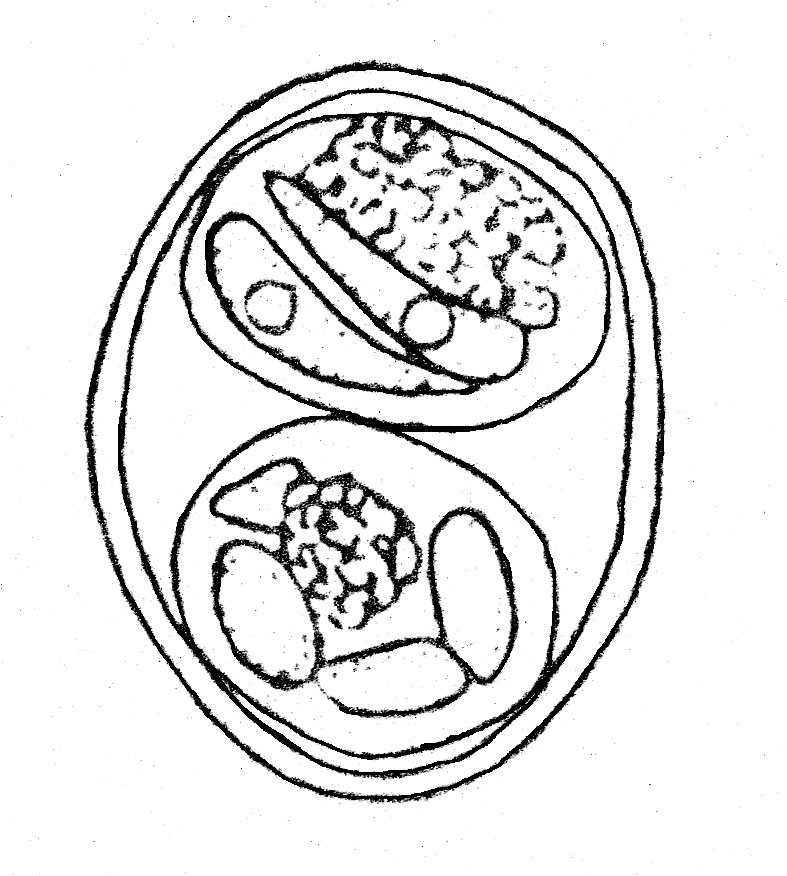Isospora wenyoni Ray and Das Gupta, 1935
Type host: Duttaphyrnus melanostictus (Schneider, 1799), Black-spined toad.
Other hosts: Fejervarya limnocharis (Gravenhorst, 1829), Indian cricket frog; Hoplobatrachus tigerinus (Daudin, 1802), Turkey frog.
Type locality: ASIA: India, Bengal, Calcutta.
Geographic distribution: ASIA: India.

Description of oocyst:
Oocyst shape: subcylindroidal;
number of walls: double contoured;
wall thickness: unknown;
wall characteristics: inner more prominent than outer, thin and fragile-looking;
L x W: 16-20 x 11-14; L/W ratio: not given; M: absent; OR: absent; PG: absent (from line drawing).
Distinctive features of oocyst: unsporulated oocysts are ovoidal or spheroidal, but become broadly ellipsoidal or ovoidal after sporulatiion; also, the very thin, fragile, 2 layered wall.
Description of sporocysts and sporozoite:
Sporocyst shape: ellipsoidal; L x W: 8 x 4; L/W ratio: ~2; SB: absent; SSB: absent; PSB: absent; SR: present;
SR characteristics: scattered granules (photomicrograph); SZ: unknown.
Distinctive features of sporocysts: their long axis is at a right angle to the long axis of the oocyst.
Prevalence: 2 of several 100 (~1%) Duttaphyrnus melanostictus.
Sporulation: Exogenous. Oocysts sporulated in ~3 days when kept in 1% chromic acid.
Prepatent and patent periods: Unknown.
Site of infection: Epithelial cells of the small intestine.
Endogenous development: Young undivided meronts (trophozoites) were 10 x 3; when mature they measured
20–25 wide and had 8–12 spindle-shaped merozoites which were 12 x 5. Each merozoite was reported to possess
a pair of hyaline blades or lamina at their anterior end, similar to those reported in the merozoites of E.
laminata by Ray (1935a). Young microgamonts were difficult to distinguish from developing meronts, but as
they aged, a large number of N were seen around the periphery of the gamont. Individual microgametes were
reported to measure 2.4 x 1.5. Early macrogamonts were easily distinguished by darkly staining cytoplasmic
granules and a spheroidal N with a karyosome. Mature macrogamonts were 16–20 x 11–14, have the posterior
end usually turned upon itself giving the impression of a short tail, and have an elongate N in which the karyosome
fragments into many small granules scattered irregularly.
Materials deposited: None.
Remarks: In an abstract, Chakravarty and Kar (1944) (erroneously?) mentioned finding oocysts of this
species in two dicroglassid species, F. limnocharis and H. tigerinus. Later, in 1952, they redescribed the
oocysts and sporocysts from these same hosts saying the oocysts were 19.8–15.4 x 15.4–13.3 and sporocysts
13.2–9.9 x 9.8–7.7, much larger than in the original description by Ray and Das Gupta (1935). Mandal (1976)
said the oocysts were 17.5 x 14.5 (15–20.5 x 13.5–15.5) with a shape index of 1.2 and that an OR was present,
but he did not show it in his line drawing; he also said the sporocysts were 11.8 x 8.5 (10–13.5 x 7.5–9.5), with L/W ratio 1.3, measurements that are significantly larger than in the original description. Finally, Mandal
(1976) noted that the sporulation time he observed was 60–70 h, similar to the 2–3 days cited by Ray and Das
Gupta (1935) in their original description. It is our opinion that both Chakravarty and Kar (1944) and Mandal
(1976) were dealing with oocysts of a species that was not I. wenyoni.
.

